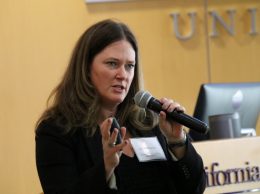Analysis: Region’s students take on less college debt than peers do
IN THIS ARTICLE
- Top Stories Topic
- Dana Olsen Author
By Dana Olsen Friday, July 12th, 2013
[EDITOR’S NOTE: Correction appended below]
While the college debt crisis has been making national headlines in recent years, students who graduated from a California school are faring relatively well compared to their counterparts in other states.
According to a report from CNBC, Americans now have more student loan debt than credit card debt, with a total figure that surpassed $1 trillion last year. But for students in California, including those who attend one of the five nonprofit four-year institutions in the Tri-Counties, the numbers are less alarming.
Across the U.S., 66 percent of students who graduated from nonprofit colleges in 2011 took on student debt, with an average loan total of about $26,000. That’s from the Institute for College Access and Success, an Oakland-based nonprofit that runs the Project on Student Debt, a research initiative dedicated to making college more available and affordable. It also compiled numbers for each individual state, with California ranking third from the bottom in terms of amount of debt owed by undergraduates.
Fifty-one percent of undergraduates who graduated in 2011 from a California school took on student debt, a number that’s 14 percent lower than the national average. And loan totals averaged $18,879 in the state during the same time period, about $7,700 below the average for students throughout the U.S.
“California has consistently been among the lowest-ranking states for student debt,” Matthew Reid, program director at the Institute for College Access and Success, told the Business Times. He said that’s due to many factors, including the fact that the state has a larger percentage of students graduating from public (as opposed to private) universities. Undergraduate students in California also receive more government grants than students in other states, largely thanks to Cal Grants, government funds dedicated to helping low- to moderate-income students pay for college at University of California and California State University schools.
The only states that had lower average debt rates than California in 2011 were Utah and Hawaii, both of which fell into the $17,000 range. The highest-average-debt states were New Hampshire, at an average of about $32,000 per undergraduate student, and Pennsylvania, at $29,959, according to the Institute for College Access and Success report.
There’s a confluence of factors contributing to the current so-called student loan debt crisis. At its core, though, the reason is fairly straightforward. “During the economic downturn and with budget difficulties, tuition went up quite a bit,” Reid said. “Certainly, the cost of attending school has gone up faster than inflation for many years. That is what drives increasing borrowing over time.”
In California, tuition has gone up at both the University of California and California State University systems, especially after the state budget was amended in recent years to take away some of the government money that was allocated to higher education. Still, undergraduate debt in the state is fairly low — and Reid said that for most students, a college degree is still a good investment because college grads do have better employment and earning prospects.
In the region
In the Tri-Counties, student loan debt at the region’s nonprofit colleges and universities are in line with the state’s average, or even slightly below.
There are two California State University schools in the region, Cal Poly San Luis Obispo and CSU Channel Islands. A Cal Poly representative told the Business Times 57 percent of undergraduate students received some kind of financial aid —loans, grants, or a combination of both — for the 2012-13 school year. Those students incurred an average debt of $15,314. That’s about $3,000 below the state average.
CSU Channel Islands, the only four-year public university in Ventura County, said the student loan data for that particular campus is not available — schools are not required to make the information public, though more than half of them do — but the university did provide the Business Times with figures for the entire CSU system, which has 23 campuses across the state. Forty-two percent of CSU students borrow student loans, and the average loan debt for those students is $15,560.
At UC Santa Barbara, the region’s only UC school, just about 50 percent of undergraduate students incur student loan debt, according to Mike Miller, director of the school’s financial aid office. The average debt is about $18,000, a number that Miller said is within a couple hundred dollars of each of the other nine UC campuses.
There are two private nonprofit colleges in the region, California Lutheran University in Thousand Oaks and Westmont College in Montecito.
While more students receive financial aid to attend those schools than the region’s public universities, it’s relevant to note that private schools are also more expensive than public ones.
A representative from CLU told the Business Times that 76 percent of undergraduate students who started at the school as freshmen and graduated in the 2011-12 school year took on debt to attend. Of those students, the average amount of debt they incurred was $26,610.
At Westmont, 60 percent of students received financial aid during the 2012-13 school year, with an average debt load of $24,000, according to the school’s financial aid office.
[CORRECTION: This article previously said that 76 percent of the undergraduate students who started at California Lutheran University in the 2011-12 school year took on debt to attend. In fact, 76 percent of undergraduate students who started at the school as freshmen and graduated in the 2011-12 school year took on debt to attend.]











